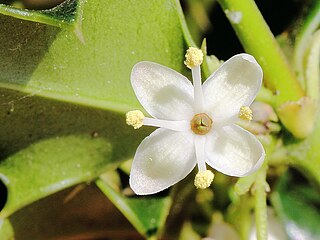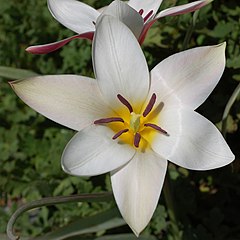Dioecy
Dioecy (
In zoology

In zoology, dioecy means that an animal is either male or female, in which case the synonym
In botany
Land plants (

In bryophytes (mosses, liverworts and hornworts), the gametophytes are fully independent plants.[9] Seed plant gametophytes are dependent on the sporophyte and develop within the spores, a condition known as endospory. In flowering plants, the male gametophytes develop within pollen grains produced by the sporophyte's stamens, and the female gametophytes develop within ovules produced by the sporophyte's carpels.[8]
The sporophyte generation of a seed plant is called "monoecious" when each sporophyte plant has both kinds of spore-producing organ but in separate flowers or cones. For example, a single flowering plant of a monoecious species has both functional stamens and carpels, in separate flowers.[10]
The sporophyte generation of seed plants is called "dioecious" when each sporophyte plant has only one kind of spore-producing organ, all of whose spores give rise either to male gametophytes, which produce only male gametes (sperm), or to female gametophytes, which produce only female gametes (egg cells). For example, a single flowering plant sporophyte of a fully dioecious species like holly has either flowers with functional stamens producing pollen containing male gametes (staminate or 'male' flowers), or flowers with functional carpels producing female gametes (carpellate or 'female' flowers), but not both.[10][11] (See Plant reproductive morphology for further details, including more complex cases, such as gynodioecy and androdioecy.)
-
In dioecious holly, some plants only have 'male' flowers with functional stamens that produce pollen.
-
Other holly plants only have 'female' flowers that produce ovules.
-
Each monoecious tulip flower has both pollen-producing stamens and carpels containing ovules.
Slightly different terms, dioicous and
Dioecy occurs in a wide variety of plant groups. Examples of dioecious plant species include ginkgos, willows, cannabis and African teak. As its specific name implies, the perennial stinging nettle Urtica dioica is dioecious,[15]: 305 while the annual nettle Urtica urens is monoecious.[15]: 305 Dioecious flora are predominant in tropical environments.[16]
About 65% of gymnosperm species are dioecious,[17] but almost all conifers are monoecious.[18] In gymnosperms, the sexual systems dioecy and monoecy are strongly correlated with the mode of pollen dispersal, monoecious species are predominantly wind dispersed (anemophily) and dioecious species animal-dispersed (zoophily).[19]
About 6 percent of
Certain
Evolution of dioecy
In plants, dioecy has evolved independently multiple times[26] generally either from hermaphroditic species or from monoecious species. A previously untested hypothesis is that this reduces inbreeding;[27] dioecy has been shown to be associated with increased genetic diversity and greater protection against deleterious mutations.[28] Regardless of the evolutionary pathway the intermediate states need to have fitness advantages compared to cosexual flowers in order to survive.[29]
Dioecy evolves due to male or female sterility,[30] although it is unlikely that mutations for male and female sterility occurred at the same time.[31] In angiosperms unisexual flowers evolve from bisexual ones.[32] Dioecy occurs in almost half of plant families, but only in a minority of genera, suggesting recent evolution.[33] For 160 families that have dioecious species, dioecy is thought to have evolved more than 100 times.[34]
In the family Caricaceae, dioecy is likely the ancestral sexual system.[35]
From monoecy
Dioecious flowering plants can evolve from
In the genus Sagittaria, since there is a distribution of sexual systems, it has been postulated that dioecy evolved from monoecy[38] through gynodioecy mainly from mutations that resulted in male sterility.[39]: 478 However, since the ancestral state is unclear, more work is needed to clarify the evolution of dioecy via monoecy.[39]: 478
From hermaphroditism
Dioecy usually evolves from hermaphroditism through gynodioecy but may also evolve through androdioecy,[40] through distyly[41] or through heterostyly.[28] In the Asteraceae, dioecy may have evolved independently from hermaphroditism at least 5 or 9 times. The reverse transition, from dioecy back to hermaphroditism has also been observed, both in Asteraceae and in bryophytes, with a frequency about half of that for the forward transition.[42]
In Silene, since there is no monoecy, it is suggested that dioecy evolved through gynodioecy.[43]
In mycology
This section relies largely or entirely upon a single source. (June 2021) ) |
Very few dioecious fungi have been discovered.[44]
Monoecy and dioecy in fungi refer to the donor and recipient roles in mating, where a nucleus is transferred from one haploid hypha to another, and the two nuclei then present in the same cell merge by karyogamy to form a zygote.[45] The definition avoids reference to male and female reproductive structures, which are rare in fungi.[45] An individual of a dioecious fungal species not only requires a partner for mating, but performs only one of the roles in nuclear transfer, as either the donor or the recipient. A monoecious fungal species can perform both roles, but may not be self-compatible.[45]
Adaptive benefit
Dioecy has the demographic disadvantage compared with hermaphroditism that only about half of reproductive adults are able to produce offspring. Dioecious species must therefore have fitness advantages to compensate for this cost through increased survival, growth, or reproduction. Dioecy excludes
See also
- Gonochorism
- Hermaphrodite
- Plant reproductive morphology
- Self-incompatibility in plants
- Sexual dimorphism
- Trioecy
References
- ^ "dioecy". Lexico UK English Dictionary. Oxford University Press. Archived from the original on December 21, 2021.
- ^ "dioecious". Lexico UK English Dictionary UK English Dictionary. Oxford University Press. Archived from the original on April 12, 2021.
- ^ "diœcious, adj". Oxford English Dictionary online. Oxford University Press. Retrieved 2021-12-21.
- ^ "Animal Diversity Web". Retrieved 27 April 2014.
- PMID 11600899.
- PMID 16338764.
- ^ a b Mauseth (2014), pp. 204–205.
- ^ Mauseth (2014), p. 487.
- ^ a b Mauseth (2014), p. 218.
- ^ Hickey, M. & King, C. (2001). The Cambridge Illustrated Glossary of Botanical Terms. Cambridge University Press.
- ^ Lepp, Heino (2007). "Case studies : -oicy : Dioicous, dioecious, monoicous and monoecious". Australian Bryophytes. Australian National Botanic Gardens and Australian National Herbarium. Retrieved 2021-06-21.
- ^ Stearn, W.T. (1992). Botanical Latin: History, grammar, syntax, terminology and vocabulary, Fourth edition. David and Charles.
- ISBN 978-0-521-70073-3.
- ^ ISBN 978-1-5272-2630-2.
- ISBN 978-981-15-4210-7.
- S2CID 90740232.
- S2CID 90740232.
- PMID 28581147.
- JSTOR 2445418.
- PMID 21646169
- doi:10.1094/PHI-I-2004-0330-01. Archived from the originalon 2016-10-05. Retrieved 2017-01-10.
- ISBN 978-1-108-49985-9.
- ISBN 0-11-310045-0
- .
- PMID 24983465.
- PMID 28555429.
- ^ PMID 32926156.
- ISBN 978-0-19-088268-6.
- ISBN 978-0-7329-4439-1.
- ISBN 978-3-319-21254-8.
- ISBN 978-3-030-46012-9.
- ISBN 978-1-134-26350-9.
- S2CID 85039623.
- ISBN 978-1-78924-190-7.
- JSTOR 2096901.
- ISBN 978-1-4398-4436-6.
- ISBN 978-0-643-09929-6.
- ^ ISBN 978-0-12-800426-5.
- PMID 22532862.
- ISBN 978-3-319-94139-4.
- ISBN 978-94-007-7347-9.
- PMID 25862920.
- ISBN 978-81-7648-737-5.
- ^ S2CID 11353336.
- S2CID 771357.
- S2CID 6839285.
- PMID 26467174.
Bibliography
- Beentje, Henk (2010). The Kew Plant Glossary. Richmond, Surrey: ISBN 978-1-84246-422-9.
- Mauseth, James D. (2014). Botany : An Introduction to Plant Biology (5th ed.). Sudbury, MA: Jones and Bartlett Learning. ISBN 978-1-4496-6580-7.



